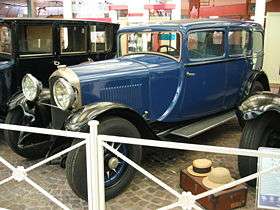Peugeot Type 174
| Peugeot Type 174 | |
|---|---|
 | |
| Overview | |
| Manufacturer | S. A. des Automobiles Peugeot |
| Production |
1923-1928 1018 produced |
| Powertrain | |
| Engine |
3.8 L straight-4 85 hp at 1900 rpm |
| Dimensions | |
| Wheelbase |
3,270 mm (128.7 in) (e.g. for sports bodies).[1] 3,500 mm (137.8 in) (for standard bodies).[1] |
| Length | 4,460 mm (175.6 in) (typically) |
| Chronology | |
| Predecessor | Peugeot Type 145 |
| Successor | Peugeot 601 |
The Peugeot Type 174, also known at the time and normally advertised simply according to its fiscal horse power as the Peugeot 18HP,[1] was a large, powerful sedan made by Peugeot from 1923 to 1926. The Type 174 S was made until 1926. The engine displaced 3828 cc, large and low-revving for a four-cylinder engine, and produced a not inconsiderable 85 horsepower. The sport version sold 208 examples compared to 810 for the standard version.
In October 1924 at the 19th Paris Motor Show the price quoted by the manufacturer for a Peugeot Type 174 in bare chassis form was 54,000 francs.[1] The sport version was priced in bare chassis form at 56,000 francs.[1]
| Wikimedia Commons has media related to Peugeot Type 174. |
References
| Peugeot, a marque of Groupe PSA, road vehicle timeline, 1889–1944 — next » | ||||||||||||||||||||||||||||||||||||||||||||||||||||||||
|---|---|---|---|---|---|---|---|---|---|---|---|---|---|---|---|---|---|---|---|---|---|---|---|---|---|---|---|---|---|---|---|---|---|---|---|---|---|---|---|---|---|---|---|---|---|---|---|---|---|---|---|---|---|---|---|---|
| Type | 1890s | 1900s | 1910s | 1920s | 1930s | 1940s | ||||||||||||||||||||||||||||||||||||||||||||||||||
| 9 | 0 | 1 | 2 | 3 | 4 | 5 | 6 | 7 | 8 | 9 | 0 | 1 | 2 | 3 | 4 | 5 | 6 | 7 | 8 | 9 | 0 | 1 | 2 | 3 | 4 | 5 | 6 | 7 | 8 | 9 | 0 | 1 | 2 | 3 | 4 | 5 | 6 | 7 | 8 | 9 | 0 | 1 | 2 | 3 | 4 | 5 | 6 | 7 | 8 | 9 | 0 | 1 | 2 | 3 | 4 | |
| Supermini | 1 | 2 | 3 / 4 | 5 / 6 / 7 / 8 | 21 / 24 / 30 / 31 | 37 | 54 | 57 | 69 "Bébé" | B P1/ B3/P1 "Bébé"¹ | 161/172 "Quadrilette" | 5CV | 190 | |||||||||||||||||||||||||||||||||||||||||||
| 26 / 27 / 28 | 48 | 56 | 58 | 126 | 201 | 202 | ||||||||||||||||||||||||||||||||||||||||||||||||||
| Small family car |
14 / 15 / 25 | 56 | 58 | 68 | VA/VC/VY¹ | V2C/V2Y¹ | VD/VD2¹ | 159 | 163 | 301 | 302 | |||||||||||||||||||||||||||||||||||||||||||||
| 33 / 36 | 63 | 99 | 108 | 118 | 125 | 173 / 177 / 181 / 183 | ||||||||||||||||||||||||||||||||||||||||||||||||||
| Family car |
9 / 10 / 11 / 12 | 16 / 17 / 19 / 32 | 49/50 | 65/67 | 77 | 78 | 88 | 127 | 143 | 153 | 153 B/BR | 176 | 401 | 402 | ||||||||||||||||||||||||||||||||||||||||||
| 18 | 39 | 43/44 | 61 | 71 | 81 | 96 | 106 | 116 | 126 | 138 | 175 | |||||||||||||||||||||||||||||||||||||||||||||
| Large family car |
23 | 42 | 62 | 72 | 82 | 92 | 104 | 112/117/ 122/130/134 | 139 | 145/146/148 | 174 | |||||||||||||||||||||||||||||||||||||||||||||
| 66 | 76 | 83 | 93 | 135 | 156 | 184 | ||||||||||||||||||||||||||||||||||||||||||||||||||
| Executive car |
80 | 103 | 113 | 141 | 147/150 | |||||||||||||||||||||||||||||||||||||||||||||||||||
| 85 | 95 | 105 | ||||||||||||||||||||||||||||||||||||||||||||||||||||||
| Cabriolet / Spider |
91 | 101/120 | 133 / 111/129/131 | 136 | 144 | |||||||||||||||||||||||||||||||||||||||||||||||||||
| Panel van | 13 | 22 | 34/35 | |||||||||||||||||||||||||||||||||||||||||||||||||||||
| Minibus | 20 / 29 | 107 | ||||||||||||||||||||||||||||||||||||||||||||||||||||||
| 1 These cars were marketed as "Lion-Peugeots", produced by what was till 1910 a separate Peugeot company, run by cousins of Armand Peugeot, then in charge of the principal automobile business.
In 1910, Armand having no sons of his own, it was agreed that the two branches of the Peugeot business be reunited. | ||||||||||||||||||||||||||||||||||||||||||||||||||||||||